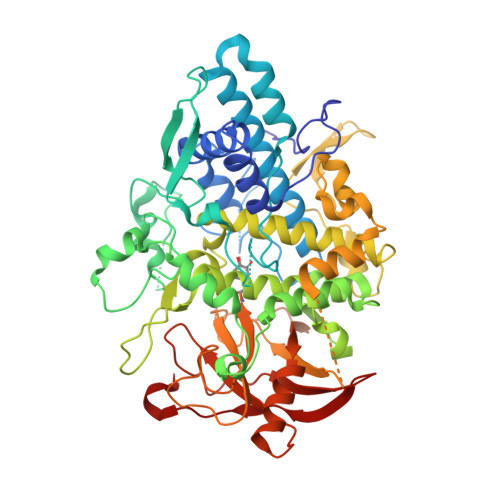Copper-Oxygen Dynamics in the Tyrosinase Mechanism.
Fujieda, N., Umakoshi, K., Ochi, Y., Nishikawa, Y., Yanagisawa, S., Kubo, M., Kurisu, G., Itoh, S.(2020) Angew Chem Int Ed Engl 59: 13385-13390
- PubMed: 32356371
- DOI: https://doi.org/10.1002/anie.202004733
- Primary Citation of Related Structures:
6JU4, 6JU5, 6JU6, 6JU7, 6JU8, 6JU9, 6JUA, 6JUB, 6JUC, 6JUD - PubMed Abstract:
The dinuclear copper enzyme, tyrosinase, activates O 2 to form a (μ-η 2 :η 2 -peroxido)dicopper(II) species, which hydroxylates phenols to catechols. However, the exact mechanism of phenolase reaction in the catalytic site of tyrosinase is still under debate. We herein report the near atomic resolution X-ray crystal structures of the active tyrosinases with substrate l-tyrosine. At their catalytic sites, CuA moved toward l-tyrosine (CuA1 → CuA2), whose phenol oxygen directly coordinates to CuA2, involving the movement of CuB (CuB1 → CuB2). The crystal structures and spectroscopic analyses of the dioxygen-bound tyrosinases demonstrated that the peroxide ligand rotated, spontaneously weakening its O-O bond. Thus, the copper migration induced by the substrate-binding is accompanied by rearrangement of the bound peroxide species so as to provide one of the peroxide oxygen atoms with access to the phenol substrate's ϵ carbon atom.
Organizational Affiliation:
Department of Applied Life Sciences, Graduate School of Life and Environmental Sciences, Osaka Prefecture University, 1-1 Gakuen-cho, Naka-ku, Sakai-shi, Osaka, 599-8531, Japan.
















